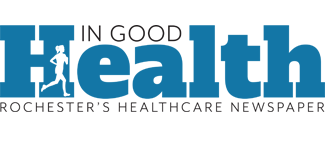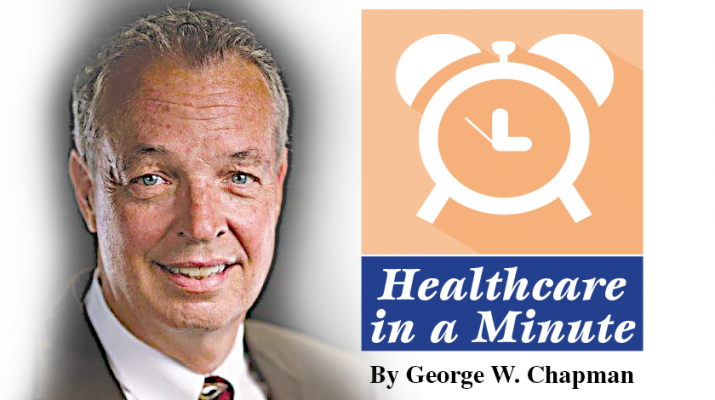By George W. Chapman
 The American Association of Medical Colleges predicts that, unless things change, the shortage of primary care docs will increase to 45,000 by 2034. A survey produced by MDLinx and administered by M3 Global research of practicing physicians revealed 42% are very concerned about the impact of the shortage on quality, 84% have already seen the quality of care compromised and 34% would not recommend pursuing a career in medicine. Ironically, medical school applications are at an all-time high.
The American Association of Medical Colleges predicts that, unless things change, the shortage of primary care docs will increase to 45,000 by 2034. A survey produced by MDLinx and administered by M3 Global research of practicing physicians revealed 42% are very concerned about the impact of the shortage on quality, 84% have already seen the quality of care compromised and 34% would not recommend pursuing a career in medicine. Ironically, medical school applications are at an all-time high.
One of the problems is there are not enough residency programs for all the medical school graduates. Medicare determines the number of residency slots per hospital and funds them. Another problem is most medical school grads are faced with tuition debt around $250,000. So the more lucrative specialties are more appealing than primary care specialties like family practice, pediatrics, internal medicine and OB-GYN. Most primary care docs work 50-60 hour weeks. Finally, third party reimbursements have not kept up with inflation so running a financially viable primary care practice is a challenge, to say the least.
Without a comprehensive national system to address and correct the impediments to pursuing primary care, it is very likely the 45,000 shortage will happen. Some ideas to make primary care more attractive are: increase and fund the number of residency slots at hospitals but only for primary care; forgive medical school debt for all primary care docs (there is such a program but the physician must work three years in a federally designated manpower shortage area); incorporate “lifestyle” medicine into the primary care purview and reimbursement which includes nutrition, diet, exercise, sleep and stress management for chronic diseases.
Finally, every year more and more physicians, in all specialties, seek employment with one of the hundreds of hospital-based healthcare systems. The business headaches of medicine are killing private practice. An effective and accessible primary care base is absolutely essential to the clinical and financial success of a large healthcare system. Absent a national fix, it may be up to savvy healthcare systems to provide more lucrative compensation packages and better working conditions for primary care physicians if we are to at least mitigate the predicted shortage.
Measles Outbreak
 Once practically eradicated, there have been measles outbreaks in six states (as of early May). Vaccine hesitancy and fatigue from the COVID-19 pandemic coupled with misinformation and even disinformation have contributed to the outbreaks. Scientific studies show that even a slight uptick in MMR vaccine use can prevent millions of new infections. JAMA recommends the first dose at 12-15 months followed by a second at 4-6 years. If the current rate of vaccination was kept constant, measles could become an epidemic with 850,000 cases over 25 years. If the current rate of vaccination decreased by just 10%, the prediction model estimates 11 million cases of measles over the next 25 years. The expense, let alone the potential deaths, would be cataclysmic. Now, if there was just a 5% increase in the current MMR vaccination rate, the prediction model estimates there would be less than 6,000 cases over 25 years. That is what is called a “tipping point.” If 95% of kids are vaccinated, we reach herd immunity. If parents refuse to vaccinate their kids, could insurance companies deny the expenses associated with treating the disease? Could insurance companies increase the premiums?
Once practically eradicated, there have been measles outbreaks in six states (as of early May). Vaccine hesitancy and fatigue from the COVID-19 pandemic coupled with misinformation and even disinformation have contributed to the outbreaks. Scientific studies show that even a slight uptick in MMR vaccine use can prevent millions of new infections. JAMA recommends the first dose at 12-15 months followed by a second at 4-6 years. If the current rate of vaccination was kept constant, measles could become an epidemic with 850,000 cases over 25 years. If the current rate of vaccination decreased by just 10%, the prediction model estimates 11 million cases of measles over the next 25 years. The expense, let alone the potential deaths, would be cataclysmic. Now, if there was just a 5% increase in the current MMR vaccination rate, the prediction model estimates there would be less than 6,000 cases over 25 years. That is what is called a “tipping point.” If 95% of kids are vaccinated, we reach herd immunity. If parents refuse to vaccinate their kids, could insurance companies deny the expenses associated with treating the disease? Could insurance companies increase the premiums?
Cherry Picking Risk
The DOJ has filed a complaint against Aetna, Elevance and Humana for allegedly paying insurance brokers or advisers millions to steer relatively healthy prospects to their plans and to steer relatively unhealthy patients to the competition. The needs of the individual patient be damned. So far, there has been no determination of liability. The services of an insurance broker or adviser are free. They are eventually paid by the insurance company selected by the client. These brokers have an ethical and fiduciary responsibility to recommend the coverage that best suits the client’s individual situation.
Loss of Trust
Former National Institutes of Health director Frank Collins, M.D, Ph.D. (note M.D. and Ph.D.) regrets when you mix politics and science, you get just politics. He observed this became baked in during the politically polarizing COVID-19 epidemic when conspiracy theories and medical quackery took hold, but probably showed early signs during the Obama administration. Before that, Collins contends, both parties were in sync and relationships between NIH-CDC-CMS-FDA and Congress were cordial and professional. You could not tell what anyone’s party affiliation was as all were interested in defeating Alzheimer’s, cancer and various diseases impacting the nation’s wellbeing.
Research was considered to be not only necessary but vital. It must have been nice back in the day to let scientists do their thing. Hundreds of researchers have been fired by the current secretary of Health.
Left in the Dark
 So what do you do when your physician or hospital no longer accepts your insurance? You are often taken by surprise with little notice. Now you have to find a new provider or switch insurance. This dilemma is happening with increasing frequency especially with Medicare Advantage plans. Fifty-four percent of 62 million Medicare eligibles are enrolled in an Advantage plan offered by commercial insurers. It is often the only Advantage plan in a market. Unlike traditional Medicare, you are limited to providers within your chosen Advantage plan. When the local hospital system can’t reach an agreement with an Advantage plan, (surprise, usually over reimbursement) you can be left holding the proverbial bag and must scramble to find another Advantage plan accepted by your physician–hospital or give up Advantage plans altogether and revert back to traditional Medicare with which virtually all docs and hospitals participate. Medicare Advantage plans have been paying out more in claims as their senior members age. If they can’t be paid more by CMS they resort to negotiating lower payments to providers. If no agreement is reached, the Advantage plan will exit the market.
So what do you do when your physician or hospital no longer accepts your insurance? You are often taken by surprise with little notice. Now you have to find a new provider or switch insurance. This dilemma is happening with increasing frequency especially with Medicare Advantage plans. Fifty-four percent of 62 million Medicare eligibles are enrolled in an Advantage plan offered by commercial insurers. It is often the only Advantage plan in a market. Unlike traditional Medicare, you are limited to providers within your chosen Advantage plan. When the local hospital system can’t reach an agreement with an Advantage plan, (surprise, usually over reimbursement) you can be left holding the proverbial bag and must scramble to find another Advantage plan accepted by your physician–hospital or give up Advantage plans altogether and revert back to traditional Medicare with which virtually all docs and hospitals participate. Medicare Advantage plans have been paying out more in claims as their senior members age. If they can’t be paid more by CMS they resort to negotiating lower payments to providers. If no agreement is reached, the Advantage plan will exit the market.
This confusion is just another reason to seriously consider universal health.
Medical Debt
 You can thank the CFPB (Consumer Fraud Protection Bureau) for keeping medical debt from being considered by lenders when it comes to loans or credit cards. But with the fate of the CFPB is now in limbo, consumer advocates fear the rule could be rescinded. The bureau has kept about $49 billion in medical bills from the credit reports of some 15 million people. Despite political pressure to kill the rule, advocates remain cautiously optimistic because the rule has bipartisan support due to the pervasiveness of medical debt (which would not exist with national universal coverage).
You can thank the CFPB (Consumer Fraud Protection Bureau) for keeping medical debt from being considered by lenders when it comes to loans or credit cards. But with the fate of the CFPB is now in limbo, consumer advocates fear the rule could be rescinded. The bureau has kept about $49 billion in medical bills from the credit reports of some 15 million people. Despite political pressure to kill the rule, advocates remain cautiously optimistic because the rule has bipartisan support due to the pervasiveness of medical debt (which would not exist with national universal coverage).
Proposed Medicaid Cuts
 As of this writing in early May, there is growing support in Congress not to slash Medicaid by $880 billion over the next 10 years. It would deny coverage for millions and place hospitals in financial jeopardy. But what is most infuriating is the belief that the Medicaid budget should be cut because of supposedly rampant waste, fraud and abuse. So throw the baby out with the wash? Fraud, waste and abuse are already sought, litigated and recovered by the HHS Office of Inspector General. There is an effective police force, so punishing medical providers and legitimate Medicaid recipients to reduce fraud is absurd. The OIG recovered more than $7 billion in 2024. It brought 1,548 criminal and civil enforcement actions including overpayments to providers, enrollees and outright criminals. So no need to slash the Medicaid budget. Increase the budget of the HHS OIG.
As of this writing in early May, there is growing support in Congress not to slash Medicaid by $880 billion over the next 10 years. It would deny coverage for millions and place hospitals in financial jeopardy. But what is most infuriating is the belief that the Medicaid budget should be cut because of supposedly rampant waste, fraud and abuse. So throw the baby out with the wash? Fraud, waste and abuse are already sought, litigated and recovered by the HHS Office of Inspector General. There is an effective police force, so punishing medical providers and legitimate Medicaid recipients to reduce fraud is absurd. The OIG recovered more than $7 billion in 2024. It brought 1,548 criminal and civil enforcement actions including overpayments to providers, enrollees and outright criminals. So no need to slash the Medicaid budget. Increase the budget of the HHS OIG.
 George W. Chapman is a healthcare business consultant who works exclusively with physicians, hospitals and healthcare organizations. He operates GW Chapman Consulting based in Syracuse.
George W. Chapman is a healthcare business consultant who works exclusively with physicians, hospitals and healthcare organizations. He operates GW Chapman Consulting based in Syracuse.

